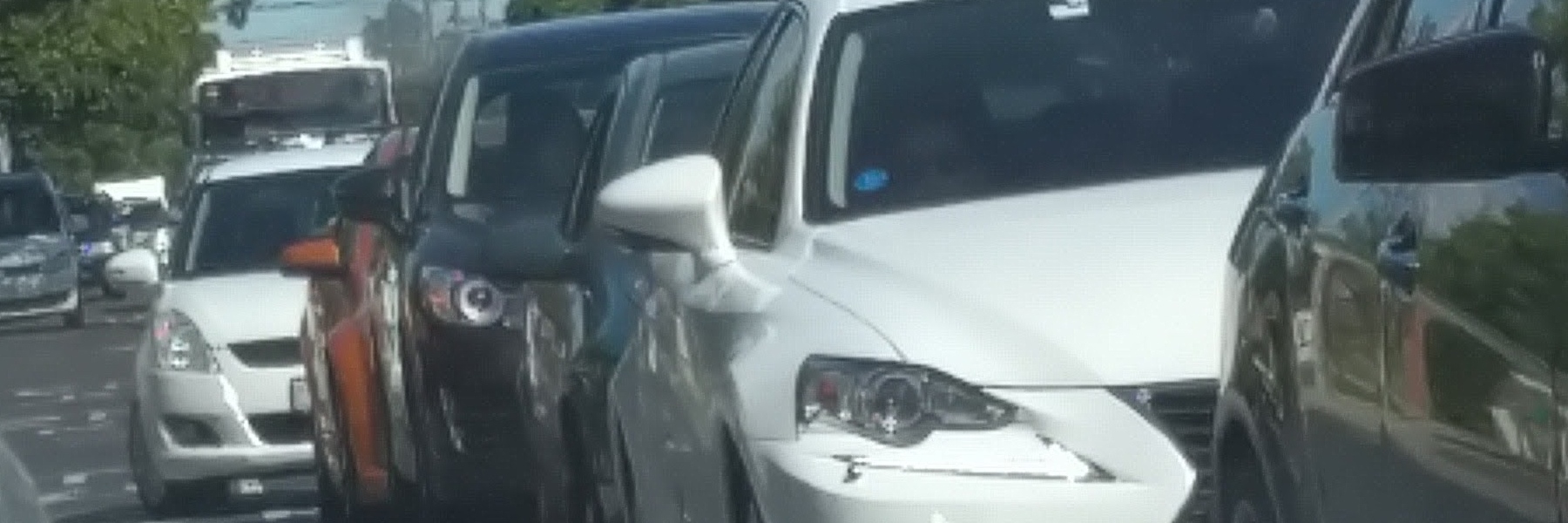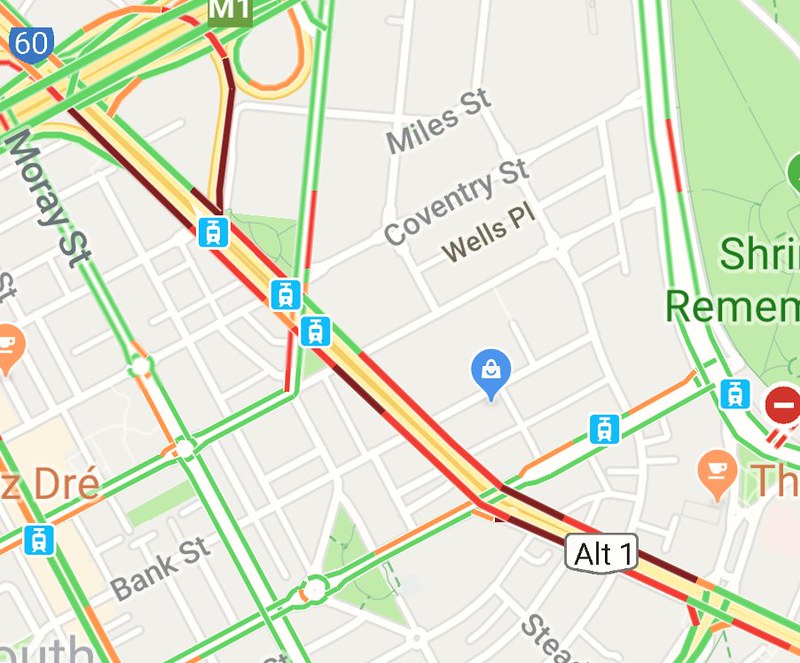A short rant.
It’s Saturday, and I’m driving in heavy traffic.
I’m making a trip that’s impractical using any other mode, alongside thousands of others, many also making trips impractical using any other mode.
It’s not about options along that particular stretch of road. It’s about the whole transport network, supporting people’s trips end to end.
On an overpass I see a train go by. It’s so crowded people are standing. Weekend frequency on that line: 20 to 30 minutes.
If a road suffered 20 minute delays, it would be shown on real-time maps as a major delay. On Melbourne’s rail network, that’s the standard wait between trains on Saturday on most lines, and has been for decades. And they’re crowded.
And 20 minutes is a good frequency on the weekend PT network. Most suburban bus routes are hourly. An hour in the car is a long trip, but it’s the wait just between buses for so many areas.
Decades of road building made suburbs car dependent. Decades of neglect and cutbacks in public transport left no other options. Weekend traffic congestion in our city is a totally expected outcome.
As I drive, I look at all the cars, my own included, stuck in the traffic, all burning energy. It just makes me angry.
Giving people viable options is not about billion-dollar infrastructure. Better infrastructure helps (especially in the areas of walking, cycling and tram accessibility), but the biggest change needed (whether money is spent on infrastructure or not) to just get PT running more frequently right through the day, every day.
All possible with the current assets.
As it stands, if they ran the road system like they do public transport, two-thirds of freeway and arterial traffic lanes would be shut outside peak hours.
Waits of 20, 30, 60 minutes are simply not good enough for a city of our size.
Fixing it in every suburb, not just some, will provide options, and more people off the roads.
But when will the decision makers do it?
Update Monday 11am: the Victorian Parliamentary Budget Office has published a cost estimate of a Greens policy: trains and trams boosted to every 10 minutes until 9pm, 7 days-a-week. For trains this came out at around $200m per year (less $50m additional fare revenue). For trams about $50m per year (less $10m additional fare revenue).
Nobody wants to doubt the PBO, but the train figure in particular is higher than some other estimates – for instance Infrastructure Victoria came up with $150-185m “on the basis of service kilometres alone”, but transport insiders believe it would be far lower.
Did the PBO simply try to extrapolate out existing per kilometre costs as IV did, ignoring that existing assets would be used, and some staff (for instance on stations) don’t need to be boosted to run more trains? Unfortunately it’s not really clear from the document.
Update Tuesday 7:30am: The Age: Trains, trams every 10-minutes on every line to cost just $200m a year


14 replies on “Weekend traffic”
I got the idea in my head to visit WestGate park, which I have never been to.
According to Google Maps, there are three bus services in the vicinity. Two don’t run at all on Sunday, and the other runs hourly.
It takes an excessive amount of mucking around with the website to find out that they don’t run, and one route is truncated about 3 km away. It is also ridiculously difficult to get from the timetable information to the map, you basically have to start again.
Part of the reason that higher frequency trains are uneconomical is presumably the seemingly high driver salaries (>$100,000) – is Melbourne looking at driverless trains à la Copenhagen at all? Surely they would scale a lot better after the initial expenditure.
There seemed to be a lot of promise toward the start of the decade, when 10 mins frequencies were beginning, the network starting to modernise, Smartbus network rolling out etc.
In the latter part of the decade especially it has been pretty sad. Patronage growth is low, far less than population growth. Bus usage is falling. The ability to get around the city seems to be getting far worse.
The government is ostensibly pushing public transport forward, but if this is the result, it’s quite sad.
After spending time in other similar cities, Melbourne starts to feel like a backwater on the transport front.
Sydney is a different league, not worth the comparison anymore, consistent decent frequencies, the NSW govt adding tens of thousands of weekly services over their term. Here they can’t even ensure buses are actually roadworthy or have sufficient fuel to make the trip. Even Auckland, which had a diesel network with hourly frequencies not that long ago now runs trains similar to Melbourne, with better frequencies at many periods.
In terms of Saturday frequency. We need to look at Sydney who has it r night. Perth has it right in terms of Bus / Train connections. Combined the 2 and you get a perfect system
Imagine a very casual public transport user trying something other than their car for something different..
-Gets to station just after a train departed, as they don’t check the timetable / are unaware of the poor 20-minute weekend frequency across much of the network
-The next train happens to be cancelled, which they’re unaware of as they’re not trained to check for disruption info, or it’s published at the last minute
-The following train arrives nearly 40 minutes after they got to the station, standing room only
Why would they come back?
A short rant. But an important rant.
If trains on the Sandy line ran every 10 minutes in off peak and weekends, I wouldn’t be tempted to drive into the city to avoid the packed trains and tedious waiting.
BTW, the vast majority of cyclists at the weekend in my area (Bayside) including me, are not travelling to a destination because they want to do something at that destination, they simply want to be on the road.
@enno, and what you’d find if you drove to Westgate Park is that there’s actually a shortage of parking due to demand, at least when the lake is doing its pink thing.
@David, Sydney has steadily increased its all-week frequencies despite having two-person crews on every train. The cost of labour is certainly a contributing factor, but hard to show it’s preventing service upgrades when tens of billions are being spent on infrastructure.
Daniel: “As it stands, if they ran the road system like they do public transport, two-thirds of freeway and arterial traffic lanes would be shut outside peak hours.”
Well, there are many roads that have half of their traffic lanes shut outside of peak hours due to permitting on-street parking! (But I agree with your point about inadequate PT frequency.)
Not to forget the trams: the St Kilda Rd routes supposedly have a 20 minute frequency in the evenings, but the intervals are sometimes stretched out by a couple more minutes. Yet these trams are often standing room only and if there’s an event (such as football) there are never any extra services with the result that the trams are so full that it can be hard to get on board.
I went through a quick look of the PBO’s costings document and I am no economics expert but it seems the year on year revenue increases seems to rise only because of the yearly inflation, and doesn’t take into account population growth or increases in the number of passengers from more people taking it up due an increased amount of services available.
And despite weekend rates, I don’t imagine that staff salaries will be significantly higher on a weekend compared to a weekday because of the lack of peak hours on weekends.
It is clear that we need more services on all modes and routes.
Perhaps, they need to run some additional services, of which are short route runs. Especially on the longer Dandenong line group. This will help mitigate the very high driver costs for those hours, and provide the capacity boost right where I guess it is needed most.
Hi Daniel,
slightly off-topic but related:
A lot of express trains in Melbourne don’t overtake trains but just catch up to the previous one. Would increased frequency (say, <10 minutes) lead to the impossibility of limited express trains on many lines and paradoxically lead to longer commutes for many?
I don’t think there are any express trains running on lines with less than 6 trains per hour (with the exception of Ringwood AM off-peak, in one direction only, which is 4 tph). Express trains tend to run on lines with express tracks.
Cutting waiting times is more important than expresses. Both can help reduce travel times, but waiting time is perceived as longer; high frequency helps connections; high frequency helps both short and long journeys; and expresses don’t save as much time as people assume (about 1 minute per station).
Expresses don’t save much time when the suburban train speeds rival trams at their maximum speed (and yes, I have been on the odd 75 tram on Burwood Highway which was able to keep up with the traffic and even overtaking some cars on the rare occasion), although I could only wish for a proper express on the Ringwood group on the weekend instead of taking nearly an hour to get to and from the city.
The Lilydale/Belgrave line is still limited to a maximum speed of 80 even on the straights, this could have easily been upgraded to 90 when the level crossings were done. While it isn’t really possible in the slow areas such as the curves around Camberwell, Canterbury, Surrey Hills, Mont Albert and Laburnum there is absolutely no reason why the relatively straight section between Blackburn and Ringwood couldn’t have a speed increase.
And off-topic, will anyone *ever* do something about the enormous amount of noise coming from the crossovers at both sides of Box Hill? Heading downhill on the centre track from Mont Albert feels like the train is about to jump off the tracks when it bounces over the crossover just past Elgar Rd (the X’Trapolis coil springs probably don’t help either in this regard). The low speed ones near the platforms are even louder due to the built up area. You can even hear it while waiting at the 109 tram terminus with all the cars flying past.